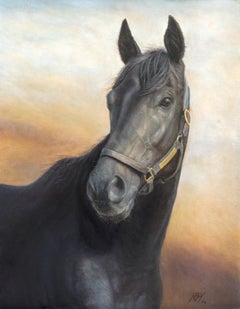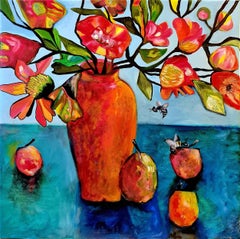Nanci France-Vaz Art
to
2
2
1
"Majestic Arabian, Thoroughbred Golden Brown" Oil Painting
By Nanci France-Vaz
Located in Denver, CO
Nanci France-Vaz's "Majestic Arabian, Thoroughbred Golden Brown" is an original, handmade oil painting that depicts a regal horse with a dark coat and wearing a leather bridle.
Category
2010s American Realist Nanci France-Vaz Art
Materials
Linen, Oil, Panel
Westwind and Wildflower
By Nanci France-Vaz
Located in Denver, CO
Westwind and Wildflower, 2021
Category
21st Century and Contemporary Nanci France-Vaz Art
Materials
Linen, Oil, Panel
Related Items
Western Scene
By Charles Damrow
Located in San Francisco, CA
This artwork "Western Scene" c.1960, is an oil painting on canvas by noted Western artist Charles Damrow, 1916-1989. It is signed at the lower left corne...
Category
Mid-20th Century American Realist Nanci France-Vaz Art
Materials
Oil
No one but the bees
Located in Zofingen, AG
Bright flowers, juicy fruits and of course the helpers of our garden: hardworking bees. They also love the juice of ripe pears. Being behind a canvas woven from my thoughts and emoti...
Category
2010s American Realist Nanci France-Vaz Art
Materials
Canvas, Oil
"Relapse" - contemporary oil painting on found object, humorous swan smoking cig
By Anthony Ackrill
Located in Sag Harbor, NY
Anthony Ackrill paints directly onto found objects, seamlessly blending painting and sculpture. In "Relapse" Ackrill depicts a swan in water, humorously smoking a cigarette. Green li...
Category
21st Century and Contemporary American Realist Nanci France-Vaz Art
Materials
Found Objects, Oil
$7,200
H 15.5 in W 20.25 in D 2 in
"Sitting Nude, Bea" 2016 oil painting of nude woman seated in thought, pink hues
By Ben Fenske
Located in Sag Harbor, NY
An oil painting of a nude female figure, sitting upon a bed; chest bent over knees, hand on head, seemingly bored. Hues of pink surround the figure due to decorative fabrics that are...
Category
21st Century and Contemporary American Impressionist Nanci France-Vaz Art
Materials
Oil, Linen
$12,000
H 27.5 in W 35.4 in
Antique American Oil Painting Framed Horse Race Elizabeth Bell Arabian Dappled
Located in Buffalo, NY
Elizabeth Bell’s Dappled Elegance is a masterfully rendered oil painting celebrating the grace and stature of an Arabian or American Saddlebred horse in motion. The artist captures t...
Category
1930s American Realist Nanci France-Vaz Art
Materials
Canvas, Oil
Death of Marat
By David Molesky
Located in Burlingame, CA
Molesky’s latest body of work approaches art history with wit and irony. Drawing from classical themes and the heroic narrative, he subverts these traditions by casting the banana as...
Category
21st Century and Contemporary Contemporary Nanci France-Vaz Art
Materials
Linen, Oil
Tranquil Renewal - original abstract impressionism landscape oil - contemporary
By Louise Fairchild
Located in London, Chelsea
This exceptional artwork is currently on display and available for sale at Signet Contemporary Art Gallery and online.
Louise Fairchild’s “Stillness in Bloom” evokes the breathless ...
Category
21st Century and Contemporary Abstract Impressionist Nanci France-Vaz Art
Materials
Canvas, Linen, Oil
$5,065
H 31.5 in W 39.38 in D 1.19 in
You are my sweet strawberry berry.
Located in Zofingen, AG
Charming, delicious still life with ripe fruits of strawberries. I just want to reach out and take a red fragrant berry. I specially applied the technique of painting, putting a deli...
Category
2010s American Realist Nanci France-Vaz Art
Materials
Canvas, Pastel, Acrylic, Cardboard
$851 Sale Price
20% Off
H 19.69 in W 27.56 in D 0.79 in
Lover Boy, colorful humorous woman and Cat
By Stephen Basso
Located in Brooklyn, NY
oil on linen on mounted board
*ABOUT Stephen Basso
Stephen Basso's highly original pastels and oil paintings are romantic, yet thought provoking fanta...
Category
2010s Outsider Art Nanci France-Vaz Art
Materials
Linen, Oil
From the life of birds
Located in Zofingen, AG
What is the basis for the exclusivity of this landscape? Firstly, the patterns!They can be used in textiles, ceramics, jewelry. Secondly, the color! A very interesting combination. V...
Category
2010s American Realist Nanci France-Vaz Art
Materials
Oil, Canvas
Stillness in Bloom- original abstract impressionism landscape oil - contemporary
By Louise Fairchild
Located in London, Chelsea
This exceptional artwork is currently on display and available for sale at Signet Contemporary Art Gallery and online.
Louise Fairchild’s “Stillness in Bloom” evokes the breathless ...
Category
21st Century and Contemporary Abstract Impressionist Nanci France-Vaz Art
Materials
Canvas, Linen, Oil
$5,065
H 31.5 in W 39.38 in D 1.19 in
"Cloud Reflections" oil painting, impressionist landscape of Vermont, Mountains
By Viktor Butko
Located in Sag Harbor, NY
"Cloud Refelctions" is an oil painting by Russian Impressionist painter Viktor Butko (b. 1978, Moscow) painted en plein air, aka outdoors. This painting is a culmination of Butko's ...
Category
21st Century and Contemporary Impressionist Nanci France-Vaz Art
Materials
Linen, Oil
Previously Available Items
Parliament of One
By Nanci France-Vaz
Located in Denver, CO
Parliament of One, 2021
Category
21st Century and Contemporary Nanci France-Vaz Art
Materials
Linen, Oil, Panel
Nanci France-vaz art for sale on 1stDibs.
Find a wide variety of authentic Nanci France-Vaz art available for sale on 1stDibs. You can also browse by medium to find art by Nanci France-Vaz in fabric, linen, oil paint and more. Not every interior allows for large Nanci France-Vaz art, so small editions measuring 14 inches across are available. Nanci France-Vaz art prices can differ depending upon medium, time period and other attributes. On 1stDibs, the price for these items starts at $4,500 and tops out at $6,000, while the average work can sell for $5,250.



